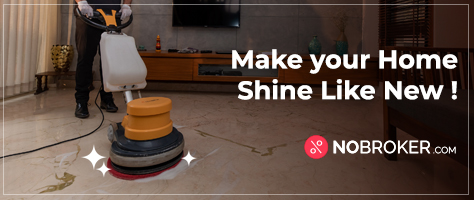Hi Buddy,
I was wondering how to do tiling on plywood, as I was remodelling my house. Here is what I discovered after looking at some expert recommendations. Tiles may generally be laid over plywood. One must, however, make sure that the plywood subfloor is one and a quarter inches (3 cm) thick. On top of the plywood, it is also advised to use a cement backer board.
To prepare the plywood for tile installation, enlist the assistance of NoBroker's skilled carpenters. How to stick tiles on plywood:- Make the plywood’s surface clean
Cleaning the plywood's surface should be your first action. The cement board installation will be simpler as a result. Scrape off any tape, glue, or dried plaster from the plywood's surface with a scraper. After that, clean or vacuum the entire area.
- Cement board installation
Over plywood, it is suggested that a cement board be installed. You must first lay out the cement board before hammering it into the plywood to install it.
Use your chalk string to indicate the locations of the nails in order to make it extremely stable.
An industry standard is to place a nail every 6 inches (15 cm) on the outside and every 8 inches (20 cm) in the middle.
On top of the cement board, use the chalk string to draw a grid design. Nails should be hammered every six inches to begin. Next, create a grid with your chalk string every 8 inches for the board's central nails.
Your use of nails could appear excessive. But it will make sure your tiled surface is sturdy and extend the life of your floor significantly.
- Set up the tiles
You should now arrange your tiles according to how you want them to appear. Generally speaking, you don't want to have a thin tile edge. Start by placing a row of tiles in the centre and checking to see if the edges line up.
If you start at one edge and arrange them sequentially, you might discover that you wind up with a very huge tile on the other wall. It is preferable, to begin with, a half-sized tile if the finished tile is too thin. Using your tile cutter, trim the tile pieces to size before starting to add the tile mortar.
- Mortar for tile
The cement board and tiles are joined together by the tile mortar. The back of the tile needs to be thoroughly covered in mortar, which is the most crucial step. This is accomplished by applying a certain method when distributing the tile mortar.
Apply a solid coating of tile mortar that is about 1/3 inch thick. Then, make grooves in the tile mortar with the notched trowel. Use grooves that are 1/3 of an inch (7 mm) deep for tiles that are the standard size of around 1 ft x 1 ft (30 cm x 30 cm).
You can alter the depth of the grooves in the mortar depending on the size of the tiles. And make them shallower for smaller tiles or deeper for larger tiles. The depth of these can only be approximated. Then periodically check your tiles to make sure you're getting adequate coverage.
Lifting up a tile after it has been installed will allow you to see whether the mortar is pretty evenly distributed and covers the tile's full bottom.
Whether you want to apply the mortar for each tile individually or in rows depends on your personal inclination. You are now prepared to put your tiles.
- Install the tiles
Start by pressing a tile firmly up against one wall before pressing it down with your hands. After that, move the tile in the opposite direction across the mortar. Pull the tile toward you, for instance, if you start at the edge that is farthest from you.
after setting the tile in the proper location. Make sure the tile has tightly adhered to the wall. Most of the time, it's easiest to begin in a corner and move along a wall.
You can add spacers to each tile corner once you've created two rows of tiles.
Your tiles will be straight and the right distance apart thanks to the spacers. Once all of the tiles have been installed and all of the spacers have been placed, give the tiling mortar 24 hours to dry.
- Apply grout to the joints as the last step
Now you must use grout to fill in the seams. Remove all the spacers first, then mix some grout.
Grout should be applied to the tile's surface and pushed into the gaps between the tiles to fill them. You can use a wet sponge, and just be careful not to use too much water when using the sponge on the grout or it will become too runny. I hope these steps suffice your query about, can you tile on plywood wall. Finally, I would also like to highlight that you can also use a sponge to remove all of the excess grout after applying it. After giving the grout some time to dry, the tiles will have a thin layer of dry grout on them. To remove any residual grout from the tile surface, use a damp cloth and rub it over the tile surface.
You have it there! That covers every process involved in tiling on plywood.
Read More:
How To Level A Floor For Tile? How To Remove Tile Glue From Wood Floor?Your Feedback Matters! How was this Answer?
Shifting, House?
✔
Lowest Price Quote✔
Safe Relocation✔
Professional Labour✔
Timely Pickup & Delivery
Intercity Shifting-Upto 25% Off
Check Prices

Intracity Shifting-Upto 25% Off
Check Prices

City Tempo-Upto 50% Off
Book Now
Related Questions
Related Questions in Flooring and Tiling Work
Most Viewed Questions
Recently Published Questions
Authors Of The Question

0 Total Answers








Can you Tile on Plywood?
Rina
181 Views
1 Answers
2 Year
2022-06-23T23:34:44+00:00 2022-06-23T23:34:45+00:00Comment
Share